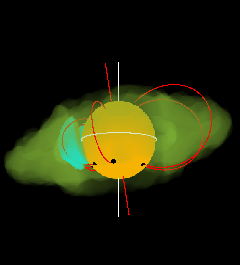Radio Observations of Jupiter
Radio emission from Jupiter was first serendipitiously discovered at decametric wavelengths by Franklin and Burke in 1955. Since that time, Jupiter has proven to have a wealth of complex radio emission mechanisms. Below 40 MHz, cyclotron-maser emission dominates, with much of this being associated with the rotational phase of the volcaninc moon Io. Between 40 MHz and a few GHz, the radio emission is dominated by synchrotron emission from magnetically trapped, highly relativistic electrons, which populate the region within a few Jovian radii of the planet. At higher frequencies, the thermal emission from the planet itself dominates -- Jupiter is often used as a calibrator at high frequencies.
Each observing band provides a different window onto Jupiter.
In recent times, interest in Jupiter's radio emissions has been rekindled by the impact of Comet Shoemaker-Levy 9 with the planet in 1994, and by NASA's Galileo space mission which has been in orbit around Jupiter since December 1995.
Here are some references to comparatively recent Jupiter-related papers by ATNF staff or using ATNF instruments.
Jupiter's Synchrotron Emission
- Radio images of Jupiter's synchrotron emission.
- 3D reconstructions of observations and modelling (movies).
- More movies.
Jupiter's Thermal Emission
Parkes Contributions to Galileo Tracking
The Parkes antenna played an important role as the downlink for the Galileo satellite.
- The Parkes Galileo Tracks - Article in Sky & Space magazine.
- The final Parkes Galileo report.
Other Sites and Links of Interest
- Sounds of Jupiter.
- The Galileo homepage.
- Jupiter scientific meetings
- The Radio JOVE project is an educational activity that brings the radio sounds of Jupiter and the Sun to students.
- JPL's Solar system dynamics homepage.

This image shows Jupiter's radiation belts on 20-July-1994, during the week of impacts of Comet Shoemaker-Levy 9. The green corresponds to the normal state of the radiation belts, and the blue to the enhanced emission. Impact sites and the magnetic field lines that thread these sites are also shown.
